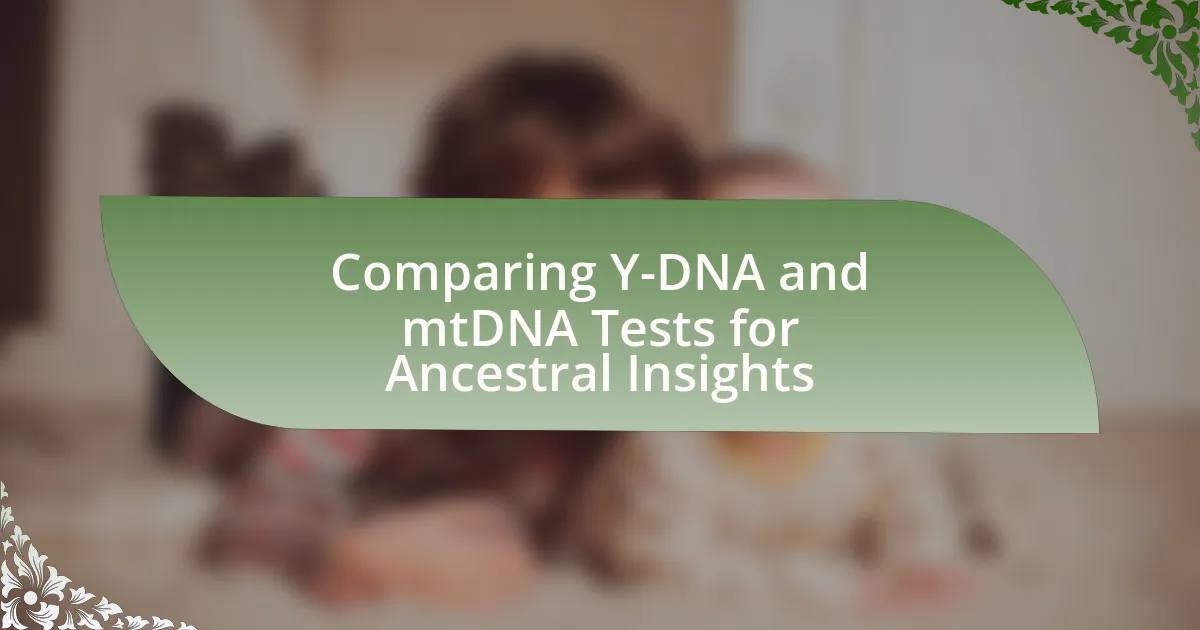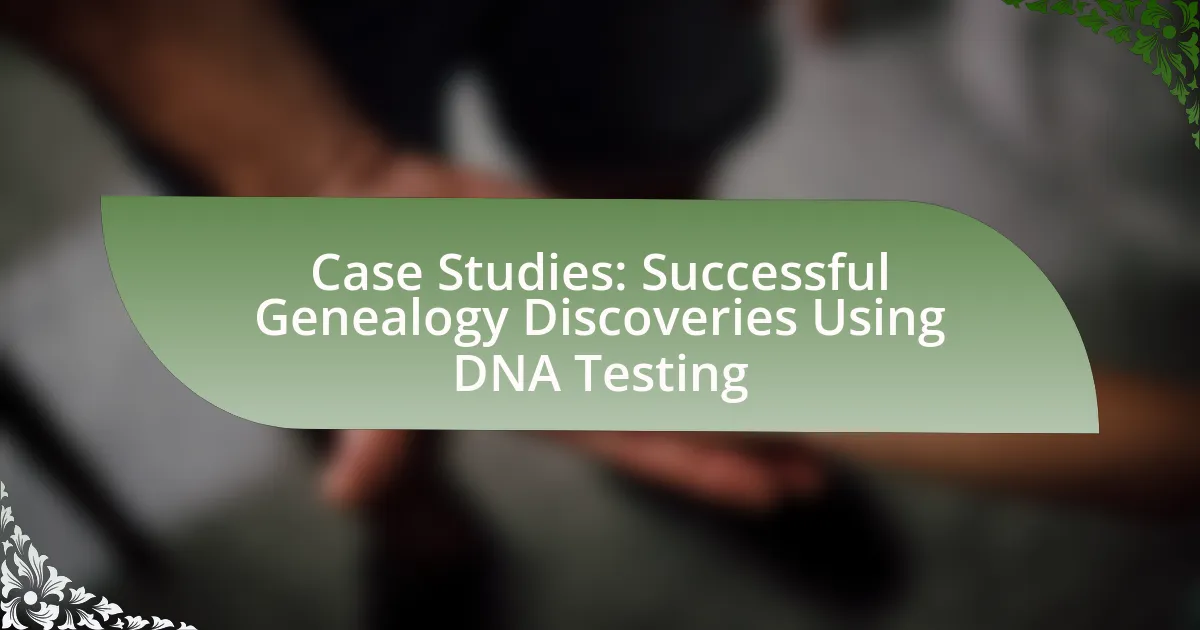The article focuses on interpreting DNA results for family history research, detailing how genetic testing reveals an individual’s ancestry and familial connections. It explains the process of generating DNA results, the types of tests available, and how different companies analyze samples. The article also covers the information provided by DNA results, including ethnicity estimates and genetic matches, while addressing the importance of accurate interpretation and common misconceptions. Additionally, it discusses challenges in interpreting results, ethical considerations, and practical tips for enhancing the analysis experience, ultimately guiding readers on how to effectively utilize their DNA findings for genealogical research.
What are DNA Results and How Do They Relate to Family History?
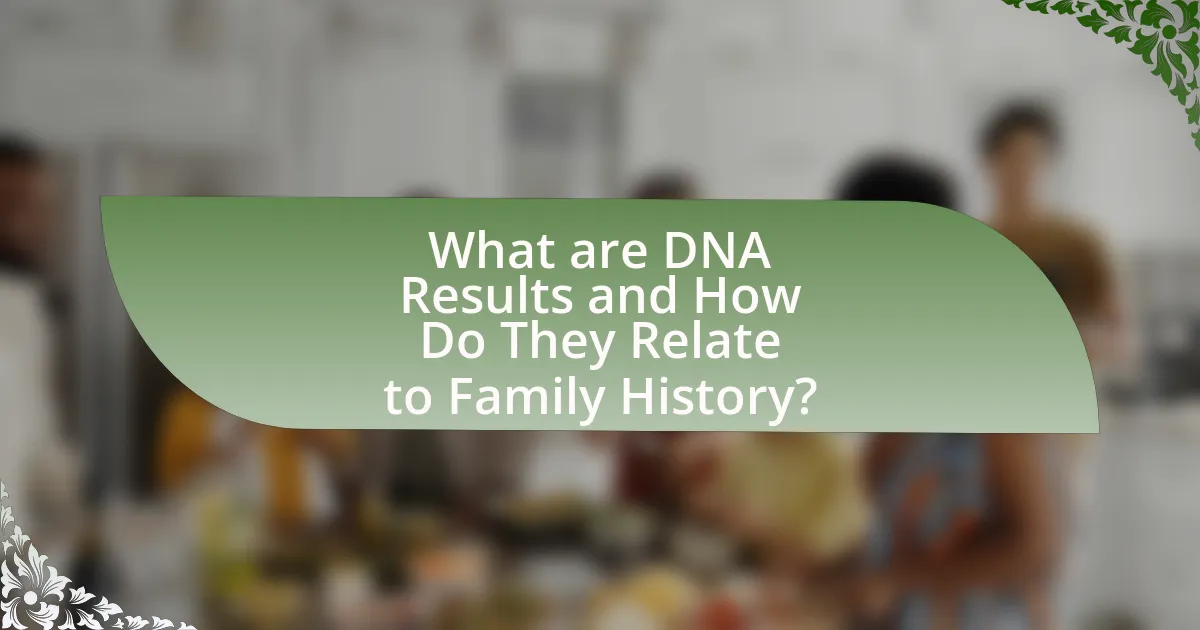
DNA results are the outcomes of genetic testing that reveal an individual’s genetic makeup, including ancestry and potential familial connections. These results can indicate ethnic backgrounds, geographic origins, and relationships to other individuals based on shared DNA segments. For example, DNA testing can identify common ancestors and provide insights into family lineage, helping individuals trace their heritage and understand their family history more comprehensively. Studies have shown that genetic testing can uncover previously unknown relatives, thereby enriching one’s understanding of familial ties and ancestral roots.
How are DNA results generated for family history research?
DNA results for family history research are generated through a process that involves collecting a DNA sample, analyzing it in a laboratory, and interpreting the genetic data. The collection typically involves a saliva or cheek swab sample, which is then sent to a genetic testing company. In the laboratory, the DNA is extracted and analyzed using techniques such as genotyping or whole genome sequencing, which identify specific genetic markers associated with ancestry and familial connections. The results are then compiled into a report that provides insights into ethnic backgrounds, potential relatives, and genealogical connections, allowing individuals to trace their family history based on genetic evidence.
What types of DNA tests are available for ancestry purposes?
There are three main types of DNA tests available for ancestry purposes: autosomal DNA tests, Y-DNA tests, and mitochondrial DNA tests. Autosomal DNA tests analyze the 22 pairs of non-sex chromosomes inherited from both parents, providing a broad overview of ancestry from all ancestral lines. Y-DNA tests focus on the Y chromosome, which is passed from father to son, allowing for the tracing of paternal lineage. Mitochondrial DNA tests examine the mitochondrial DNA passed from mother to child, enabling the exploration of maternal ancestry. These tests are widely used by genealogists and individuals seeking to understand their heritage and family history.
How do different DNA testing companies process samples?
Different DNA testing companies process samples through a series of standardized steps that typically include sample collection, DNA extraction, amplification, and analysis. Initially, companies provide customers with a collection kit, which usually contains a swab or saliva collection tube. After the sample is collected, it is sent to the company’s laboratory, where DNA is extracted from the biological material.
Following extraction, the DNA undergoes amplification using techniques such as Polymerase Chain Reaction (PCR) to create sufficient quantities for analysis. The amplified DNA is then analyzed using various methods, including genotyping or sequencing, to identify specific genetic markers. Each company may utilize proprietary algorithms and databases to interpret the results, providing insights into ancestry and genetic traits.
For instance, companies like AncestryDNA and 23andMe employ different reference populations and methodologies for their analyses, which can lead to variations in results. This systematic approach ensures that the DNA testing process is reliable and reproducible across different companies.
What information can DNA results provide about my ancestry?
DNA results can provide detailed insights into your ancestry, including ethnic origins, geographic lineage, and potential familial connections. These results analyze specific markers in your DNA to estimate the percentage of your ancestry from various regions around the world, often breaking it down into specific ethnic groups. For example, a DNA test might reveal that you have 30% Irish ancestry, 20% Italian ancestry, and 50% from other regions. Additionally, DNA results can identify genetic relatives by comparing your DNA with that of others in the database, potentially uncovering unknown relatives or ancestral connections. This information is derived from extensive databases and algorithms that compare genetic markers across populations, providing a scientifically-backed understanding of your heritage.
How do ethnicity estimates work in DNA results?
Ethnicity estimates in DNA results work by analyzing an individual’s genetic markers and comparing them to reference populations from various regions around the world. These estimates are generated through algorithms that assess the percentage of an individual’s DNA that matches the genetic profiles of these reference groups, which are based on extensive genetic research and population studies. For example, companies like AncestryDNA and 23andMe utilize large databases of genetic information to determine the likelihood that a person’s ancestry comes from specific ethnic groups, providing insights into their heritage. The accuracy of these estimates relies on the diversity and size of the reference populations, as well as the methodologies used in the analysis.
What are genetic matches and how can they help in family history research?
Genetic matches are individuals who share a significant amount of DNA with you, indicating a common ancestor. These matches can assist in family history research by providing clues about lineage and ancestral connections, allowing researchers to trace family trees more accurately. For example, DNA testing services often display shared segments of DNA, which can help identify relatives and establish relationships, thereby enhancing the understanding of familial ties and heritage.
Why is it important to interpret DNA results accurately?
Accurate interpretation of DNA results is crucial because it directly impacts the understanding of genetic heritage and potential health risks. Misinterpretation can lead to incorrect conclusions about family relationships, ancestry, and inherited conditions, which may affect personal decisions and medical care. For instance, a study published in the journal “Nature” found that inaccurate genetic testing could result in misdiagnosis or inappropriate treatment plans, emphasizing the need for precision in genetic analysis.
What common misconceptions exist about DNA results?
Common misconceptions about DNA results include the belief that DNA tests can definitively determine ancestry or ethnicity, and that they provide a complete picture of an individual’s genetic heritage. In reality, DNA tests offer estimates based on reference populations, which can vary significantly and may not account for all ancestral lines. Additionally, many people mistakenly think that DNA results can reveal specific health risks or traits with absolute certainty; however, most tests only indicate potential predispositions rather than guarantees. These misconceptions stem from the complex nature of genetics and the limitations of current testing methodologies, which often rely on statistical models rather than direct lineage tracing.
How can misinterpretation of DNA results affect family history research?
Misinterpretation of DNA results can lead to inaccurate conclusions about family history, potentially causing individuals to trace incorrect ancestral lines. When DNA results are misunderstood, it may result in false assumptions about relationships, such as identifying non-existent relatives or overlooking actual connections. For instance, a person might misinterpret a genetic match as a close relative when it is actually a distant connection, leading to misguided research efforts. This can distort the understanding of family lineage and heritage, as evidenced by studies showing that misinterpretations can occur in up to 30% of cases when individuals lack genetic knowledge. Thus, accurate interpretation is crucial for reliable family history research.
How Can I Analyze My DNA Results for Family History?
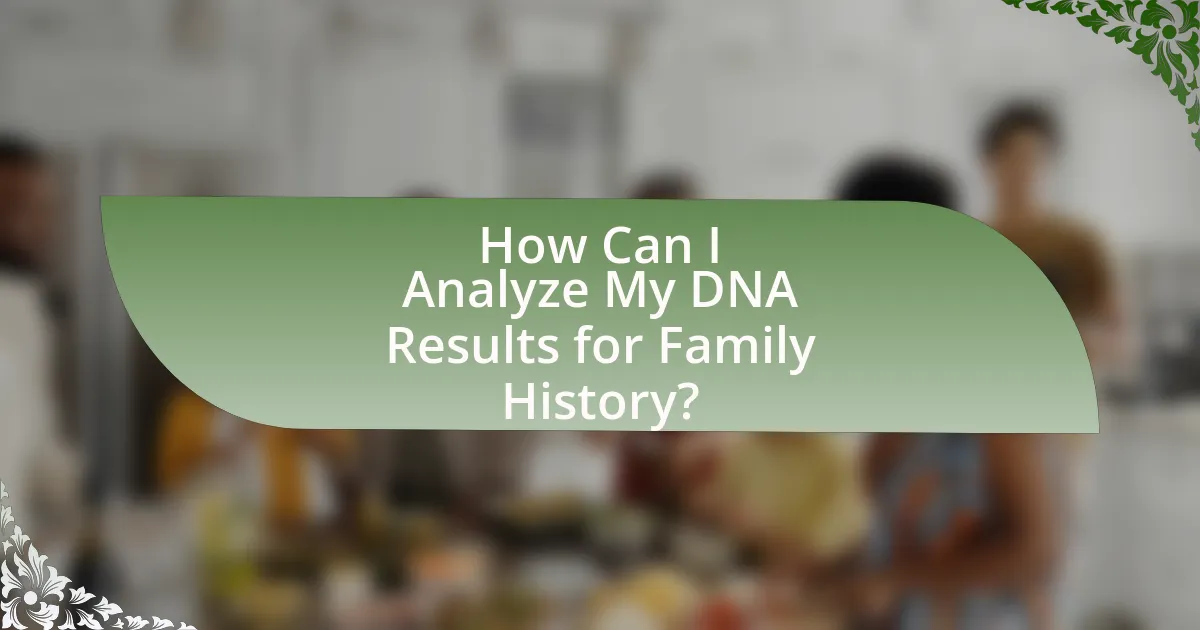
To analyze your DNA results for family history, start by accessing the raw data provided by your DNA testing service, such as AncestryDNA or 23andMe. Utilize tools like genetic genealogy software or online platforms that allow you to compare your results with others, identify potential relatives, and explore ancestral origins. For instance, AncestryDNA provides a family tree feature that helps visualize connections based on shared DNA segments. Additionally, consider joining genealogy forums or groups where you can share insights and collaborate with others researching similar family lines. This approach is supported by the fact that many users have successfully traced their lineage and discovered new relatives through collaborative analysis of DNA results.
What steps should I take to begin analyzing my DNA results?
To begin analyzing your DNA results, first, access the results through the platform where you submitted your DNA sample. This typically involves logging into your account on the testing service’s website. Next, familiarize yourself with the key components of your results, such as ethnicity estimates, genetic matches, and health reports. Understanding these sections will help you interpret the data effectively. Additionally, consider using third-party tools or resources that can provide deeper insights into your results, such as GEDmatch or DNA Painter, which allow for more detailed analysis and visualization of your genetic connections.
How do I access and navigate my DNA results online?
To access and navigate your DNA results online, log into the website of the DNA testing service you used, such as AncestryDNA or 23andMe. Once logged in, locate the section labeled “DNA Results” or “My Results” on the dashboard. This section typically provides an overview of your genetic information, including ancestry composition and health reports. You can click on specific categories to explore detailed insights, such as ethnic breakdowns or genetic traits. Most platforms also offer tools for comparing results with relatives and accessing additional resources for interpretation.
What tools are available for analyzing DNA results?
Various tools are available for analyzing DNA results, including software and online platforms such as GEDmatch, AncestryDNA, 23andMe, and Family Tree DNA. GEDmatch allows users to compare their DNA results with others and provides tools for ancestral research. AncestryDNA and 23andMe offer user-friendly interfaces for interpreting genetic data, including ethnicity estimates and health reports. Family Tree DNA specializes in Y-DNA and mitochondrial DNA testing, which can help trace paternal and maternal lineages. These tools are widely used in genealogical research and provide insights into family history through genetic connections.
How can I connect with potential relatives through my DNA results?
To connect with potential relatives through your DNA results, utilize the matching features provided by DNA testing companies. These companies, such as AncestryDNA and 23andMe, offer tools that identify genetic matches based on shared DNA segments, indicating possible familial relationships. By reviewing your list of matches, you can reach out to individuals who share a significant amount of DNA with you, suggesting a common ancestor. Additionally, engaging in family trees and shared ancestry features on these platforms can enhance your ability to connect with relatives and explore your family history further.
What should I do if I find a genetic match?
If you find a genetic match, you should reach out to the individual to discuss your shared ancestry. Initiating contact can help clarify the relationship and provide insights into your family history. Many genetic testing platforms offer messaging features to facilitate this communication, allowing you to exchange information about your family trees and any known relatives. Engaging with your genetic match can lead to valuable discoveries about your heritage and potentially connect you with previously unknown relatives.
How can I reach out to potential relatives for collaboration?
To reach out to potential relatives for collaboration, utilize DNA testing platforms that offer features for connecting with genetic matches. These platforms often provide messaging systems or forums where users can introduce themselves and propose collaborative projects, such as family tree building or genealogical research. For instance, AncestryDNA and 23andMe allow users to view shared DNA matches and send messages directly to those individuals, facilitating communication and collaboration on family history exploration.
What are the best practices for documenting my findings?
The best practices for documenting findings in the context of interpreting DNA results for family history include maintaining clear and organized records, using standardized terminology, and ensuring accuracy in data entry. Clear records facilitate easy retrieval and understanding of findings, while standardized terminology enhances communication and reduces confusion among researchers and family members. Accuracy in data entry is crucial, as errors can lead to incorrect conclusions about family lineage. Additionally, utilizing digital tools and software designed for genealogical research can streamline the documentation process and provide backup options for data security.
How can I organize my family history research effectively?
To organize family history research effectively, create a structured system that categorizes information by family branches, individuals, and relevant documents. Start by using genealogy software or online platforms that allow you to input data, attach documents, and visualize family trees. This method enhances accessibility and ensures that all information is systematically stored.
Additionally, maintain a consistent naming convention for files and documents, such as using the individual’s name and date, which facilitates easy retrieval. Regularly back up your data to prevent loss, and consider creating a timeline of events for each family member to contextualize their lives within historical events. This approach not only organizes your research but also provides a clearer understanding of your family’s history in relation to broader historical contexts.
What resources are available for further learning about DNA interpretation?
Resources for further learning about DNA interpretation include online courses, textbooks, and scientific journals. Online platforms such as Coursera and edX offer courses on genetics and DNA analysis, providing structured learning from reputable institutions. Textbooks like “Genetics for Dummies” and “The Science of DNA” offer foundational knowledge and practical insights into DNA interpretation. Additionally, scientific journals such as “Nature Genetics” and “The American Journal of Human Genetics” publish peer-reviewed articles that explore the latest research and methodologies in DNA analysis, making them valuable resources for advanced understanding.
What Challenges Might I Encounter When Interpreting DNA Results?
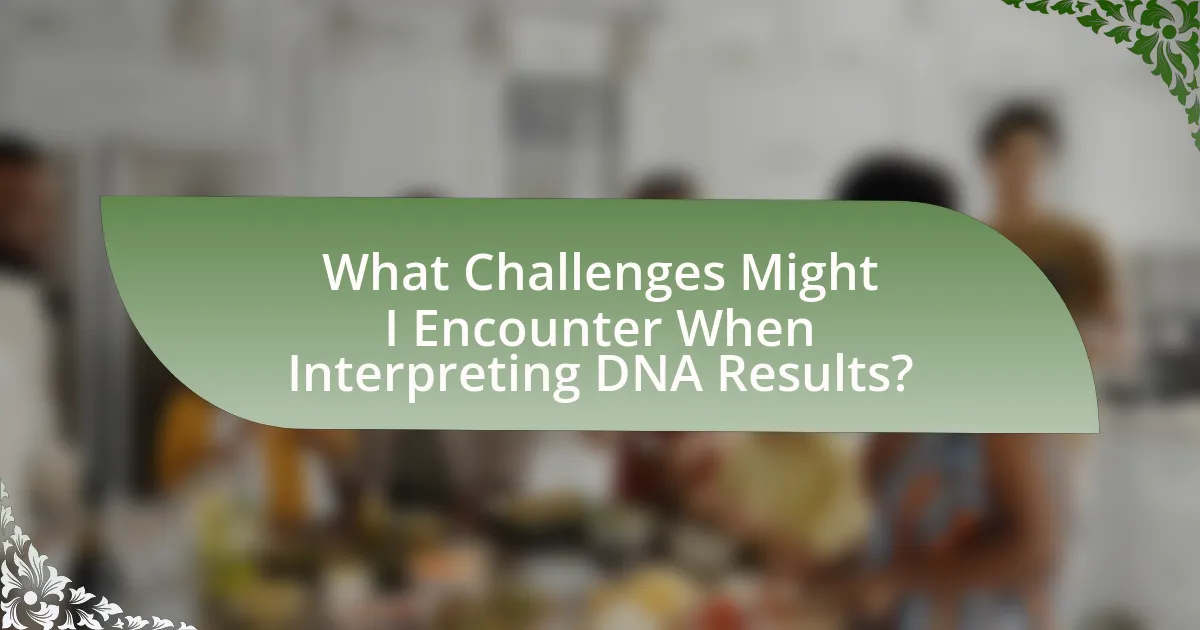
Interpreting DNA results can present several challenges, including understanding genetic terminology, distinguishing between correlation and causation, and dealing with unexpected findings. Genetic terminology can be complex, making it difficult for individuals to grasp the significance of specific markers or variants. Additionally, while DNA results may indicate a potential relationship or ancestry, they do not confirm it definitively, leading to possible misinterpretations. Unexpected findings, such as discovering unknown relatives or unexpected ethnic backgrounds, can also create emotional and psychological challenges, complicating the interpretation process.
What are the limitations of DNA testing for family history?
DNA testing for family history has several limitations, including incomplete ancestry information, potential inaccuracies in ethnicity estimates, and the inability to trace all familial connections. These tests often rely on reference populations that may not represent all genetic backgrounds, leading to skewed results. Additionally, DNA testing cannot provide information about non-genetic factors such as cultural or social influences on family history. Furthermore, privacy concerns arise as genetic data can be shared or misused by third parties, complicating the interpretation of results.
How can I address unexpected results or surprises in my DNA findings?
To address unexpected results or surprises in DNA findings, individuals should first consult with a genetic counselor or a professional in genetics. This expert can help interpret the results accurately and provide context regarding the implications of unexpected findings. Genetic counselors are trained to explain complex genetic information and can assist in understanding how these results may affect family history or health. Additionally, reviewing the methodology of the DNA test and considering the possibility of errors or limitations in the testing process can provide clarity. Research indicates that genetic testing can yield unexpected results due to factors such as non-paternity events or previously unknown ancestry, which underscores the importance of professional guidance in interpreting these findings.
What ethical considerations should I keep in mind when interpreting DNA results?
When interpreting DNA results, it is crucial to consider the implications of privacy, consent, and potential emotional impact on individuals and families. Privacy concerns arise from the sensitive nature of genetic information, which can reveal not only personal health risks but also familial relationships. Consent is essential, as individuals should be informed about how their genetic data will be used and shared, particularly if it involves relatives who may not have consented to testing. Additionally, the emotional impact of discovering unexpected familial connections or health predispositions can be significant, necessitating a thoughtful approach to discussing and sharing results. These ethical considerations are supported by guidelines from organizations such as the American Society of Human Genetics, which emphasizes the importance of informed consent and the responsible use of genetic information.
How can I troubleshoot common issues with DNA interpretation?
To troubleshoot common issues with DNA interpretation, first, verify the accuracy of the data by cross-referencing results with multiple sources or databases. This step is crucial because discrepancies can arise from errors in sample processing or data entry. Next, ensure that the interpretation aligns with established genetic markers and known genealogical connections, as misinterpretation can occur if the context of the results is not properly understood. Additionally, consult with genetic counselors or experts who can provide insights into complex results, as they can clarify ambiguous findings and help contextualize them within family history. Finally, utilize online forums or communities focused on genetic genealogy, where shared experiences can offer solutions to similar issues encountered by others.
What should I do if my results are inconclusive or confusing?
If your results are inconclusive or confusing, you should seek clarification from a genetic counselor or a professional in genetic testing. Genetic counselors can help interpret the results, provide context, and suggest further testing if necessary. They are trained to understand the complexities of genetic data and can guide you through the implications for your family history. Additionally, reviewing the methodology of the DNA test and considering retesting with a different service may also provide clearer insights.
How can I seek help from experts in genetic genealogy?
To seek help from experts in genetic genealogy, you can start by joining online forums and communities dedicated to genetic genealogy, such as the International Society of Genetic Genealogy (ISOGG) or the Genetic Genealogy Tips & Techniques Facebook group. These platforms provide access to knowledgeable individuals who can offer guidance and answer specific questions. Additionally, consider hiring a professional genetic genealogist through reputable organizations like the Association of Professional Genealogists (APG), which maintains a directory of certified experts. Engaging with these resources allows you to receive tailored advice and insights based on your unique DNA results and family history.
What practical tips can enhance my DNA interpretation experience?
To enhance your DNA interpretation experience, focus on utilizing reliable resources and tools. Start by using reputable genetic testing services that provide comprehensive reports, as these often include detailed explanations of genetic markers and their implications for ancestry. Additionally, engage with online platforms and forums dedicated to genealogy, where you can share insights and ask questions from experienced users.
Moreover, consider using visualization tools that can help you better understand your genetic data, such as chromosome mapping software, which allows you to see how your DNA segments relate to your family tree. Lastly, keep a detailed record of your findings and any connections you make, as this will help you track your research progress and clarify relationships over time.
How can I stay organized while interpreting my DNA results?
To stay organized while interpreting your DNA results, create a structured system for documenting and analyzing the information. Start by categorizing your results into sections such as ancestry, health traits, and genetic matches. Use spreadsheets or dedicated software to log findings, making it easier to track relationships and patterns. Additionally, maintain a timeline of your research process, noting key discoveries and sources for reference. This methodical approach enhances clarity and allows for efficient retrieval of information, which is crucial for understanding complex genetic data.
What are the best resources for ongoing education in DNA analysis?
The best resources for ongoing education in DNA analysis include online courses, academic journals, and professional organizations. Online platforms like Coursera and edX offer courses from universities such as Stanford and MIT, focusing on genetics and bioinformatics. Academic journals like “Nature Genetics” and “The American Journal of Human Genetics” publish peer-reviewed research that keeps professionals updated on the latest findings. Additionally, organizations such as the American Society of Human Genetics provide workshops, webinars, and conferences that facilitate continuous learning and networking opportunities in the field of DNA analysis.



